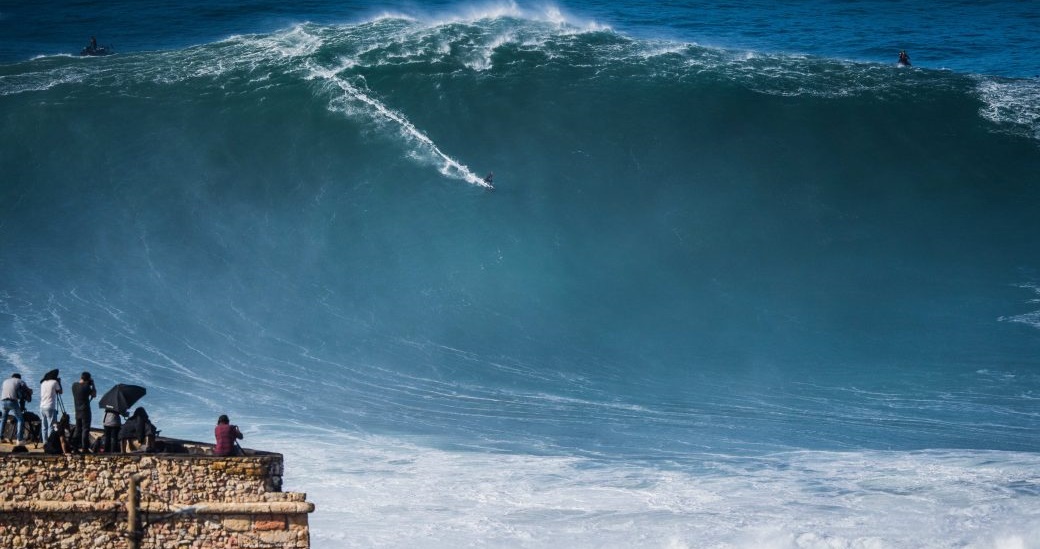How are the giant waves of Nazaré formed?

26.21 meters – that’s how high the wave was that the German Sebastian Steudtner chased down in Nazaré in October 2020 at 80 km/h. For this, the 37-year-old has now officially received an entry in the Guinness Book of Records, because no one has ever surfed a higher wave before. But how do the giant waves of Nazaré actually form?
Giant waves more than 30 meters high are not uncommon in Nazaré in Portugal. The beach with the monster waves is legendary, but also feared. Because surfers keep injuring themselves while riding the mega waves. For some, the ride even ended fatally.
Only in January did surfing accidents occur again in Nazaré. As BILD reports with reference to centrotv.sapo.pt, the American CJ Macias broke his arm after a fall. France’s Pierre Rollet was also injured and had to be taken to hospital. The French Justine Dupont, who came dangerously close to the rocks after her fall, could be treated on site.
Surf records in Nazaré
The Brazilian Maya Gabeira also knows how dangerous the giant waves can be. In 2013 she fell badly while attempting a surfing world record. Luckily for her, she was revived. In 2020 she finally broke her own surfing record in Nazaré when she conquered a 22.40 meter high wave. At that height, it was the largest wave ever surfed by a woman. In 2018, Gabeira set a world record in Nazaré, Portugal, with a giant wave more than 20 meters high.
It wasn’t the first – records for the highest surfed wave in the world have often been set here. Giant waves of more than 30 meters are not uncommon in the Portuguese town. Even pro surfers like Hugo Vau and Garrett McNamara have conquered the so-called “Big Waves” of Portugal.
On October 29, 2020, Sebastian Steudtner finally conquered a giant wave of 26.21, for which he received an entry in the Guinness Book of Records on Tuesday (May 24).
How are the giant waves of Nazaré formed in Portugal?
Winter is the season of high-rise giant waves in Nazaré, Portugal. At this time, surfers and onlookers flock to the small town on the Atlantic. There you can observe the water giants and their conquerors, who appear tiny in comparison, up close. At a safe distance, spectators stand on the dunes or at the lighthouse, which rises above the water on a small fortress. The wave-watchers watch as the masses of water roll in with a deafening roar, slowly pile up to break at their zenith and then slap white water spray onto the Praia do Norte beach.
What the wave lovers don’t see is what happens before. The factors that play together to create the giant waves are unknown to many. The Hydrographic Institute (HI) in Lisbon explains that the phenomenon of the Portuguese monster waves is an interaction of several mechanisms. Just a few hundred meters off the coast of the city of Nazaré is the deep sea gorge Nazaré Canyon. With a length of 170 kilometers and a depth of around 5,000 meters, the canyon plays a decisive role in the formation of giant waves.
Canyon in the ocean as the source of the giant wave
The water on the continental shelf is much shallower in comparison. The difference in depth changes the speed and direction of the ocean currents. Various zones are created in which the waves converge, as the HI writes. “This process appears to be particularly effective during the prevailing north-west and west swell periods in the area off Praia do Norte,” explains the institute. Since the wave is generated near shore, the current from the local water channel acts as an “additional mechanism” on its height. Add to this a perfect wind speed and direction and the 20 to 30 meter high water walls are created. With a view like this, it’s no wonder the Portuguese coastal town draws so many spectators.
The Nazaré Canyon was discovered thousands of years ago. According to the Hydrographic Institute, it was considered an “unfathomable abyss” in ancient times. It was not until the beginning of the 20th century that researchers took on the deep-sea gorge and carried out the first measurements. Therefore, today we not only know the size of the canyon, but can also understand how these giant waves are created in Portugal. In addition, this knowledge is essential for the big wave professionals who always regularly set new world records in Nazaré.




